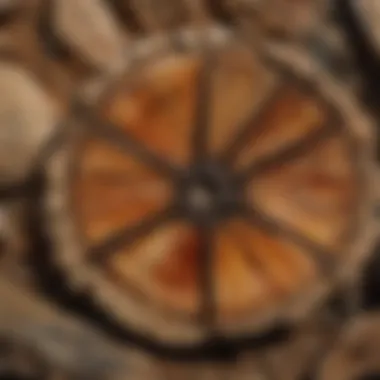Unveiling the Hidden Gems: A Comprehensive Guide to Evaluating the Value of Rocks and Fossils


Rock and Fossil Identification
Rock and fossil identification forms the cornerstone of collecting these geological marvels. To embark on this captivating journey, one must first acquaint themselves with different types of rocks and fossils, ranging from sedimentary to igneous and metamorphic rocks, along with an array of fossils such as petrified wood or dinosaur remains. Characteristics play a crucial role in discerning between various specimens, including color, texture, hardness, and mineral composition. Enthusiasts rely on tools like magnifying lenses, UV lights, and hardness picks to aid in the identification process, ensuring accuracy and precision in cataloging their finds.
Collecting Tips and Techniques
Venturing into the realm of rock and fossil collection demands a nuanced approach to ensure success in uncovering valuable specimens. Adopting best practices involves thorough research on prime collecting sites, which may include quarries, riverbanks, or desert plains rich in geological diversity. Safety is paramount during specimen extraction, requiring delicate tools like chisels, brushes, and gloves to avoid damage and ensure preservation. Understanding the geological makeup of a site and applying proper extraction techniques are fundamental in enhancing the quality of collected rocks and fossils.
Preservation and Display
Preserving the integrity of collected rocks and fossils is essential to prolong their lifespan and retain their value over time. Utilizing techniques such as remove display. Proper storage methods, including the use of archival-quality boxes, acid-free paper, and silica gel packs, prevent deterioration and maintain the pristine condition of specimens. Creativity flourishes in displaying these geological treasures, with possibilities ranging from mounted frames and shadow boxes to minimalist shelves, each enhancing the aesthetic appeal while safeguarding the specimens from environmental factors.
Geological Insights
Delving deeper into the geological aspects of rock and fossil collection unveils a treasure trove of insights into Earth's history and natural processes. Examining geological formations provides valuable context on the conditions under which rocks and fossils originate, offering clues to past climates and habitats. The historical significance of certain specimens sheds light on pivotal moments in Earth's evolution, enriching collectors' appreciation for these relics of the past. Notable discoveries within the field greatly contribute to scientific knowledge, further fueling exploration and excavation endeavors in the pursuit of uncovering hidden gems within the world of rocks and fossils.
Introduction
Our exploration will not only uncover the tangible monetary worth of rocks and fossils but also reveal the invaluable historical and cultural significance embedded within each unique specimen. By venturing into the captivating world of relic collection, enthusiasts will gain a profound appreciation for the geological treasures that have endured through time.
Throughout this comprehensive guide, we will navigate through the factors that influence the price of these geological wonders, elucidate market dynamics, and provide insights into preserving the value of one's collection. Our goal is to equip both novice collectors and seasoned enthusiasts with the knowledge and tools necessary to navigate this enthralling domain with confidence and insight.
Understanding the Value of Rocks and Fossils
Factors Influencing Price
Rarity and Uniqueness
Rarity and uniqueness play pivotal roles in influencing the price of rocks and fossils. The scarcity of a specimen and its distinctive features contribute significantly to its market value. Collectors often seek out rare pieces that stand out due to their uncommon characteristics, making them highly desirable in the world of relic collection. While rarity can elevate the worth of a specimen, it may also limit its accessibility, posing challenges for enthusiasts looking to expand their collections.
Condition and Preservation
The condition and preservation of rocks and fossils are essential factors in determining their price. Specimens that are well-preserved and in optimal condition tend to command higher values in the collectors' market. Maintaining the integrity of these geological treasures ensures their longevity and attractiveness to potential buyers. Conversely, poor condition or inadequate preservation may diminish the value of the specimen, highlighting the significance of proper care and conservation practices.
Demand and Trends
The dynamics of demand and trends have a significant impact on the pricing of rocks and fossils. Shifting patterns in collectors' preferences and market trends can influence the perceived value of certain specimens. Understanding the current demand for specific types of rocks and fossils enables collectors to stay informed about potential fluctuations in prices. By keeping abreast of market trends, enthusiasts can make strategic decisions when acquiring or selling their prized geological finds.
Assessing Market Value
Researching Comparable Sales


Researching comparable sales is a fundamental aspect of assessing the market value of rocks and fossils. By studying previous transactions involving similar specimens, collectors can gain insights into prevailing price ranges and market trends. This comparative analysis helps individuals determine a reasonable value for their own collections, taking into account factors like rarity, condition, and demand.
Consulting Expert Appraisers
Consulting expert appraisers provides collectors with specialized knowledge and insights into the valuation of rocks and fossils. Appraisers offer professional expertise in assessing the worth of geological specimens, considering various factors that may impact their market value. By seeking guidance from experts in the field, collectors can receive valuable appraisals that reflect the true significance of their collections.
Evaluating Online Platforms
Evaluating online platforms is a practical method for determining the market value of rocks and fossils. Online marketplaces and auction sites allow collectors to gauge the demand for specific specimens and observe ongoing bidding activities. By monitoring these platforms and analyzing sales data, enthusiasts can stay informed about current pricing trends and make well-informed decisions regarding their collections.
Determining Intrinsic Worth
Geological Significance
The geological significance of rocks and fossils contributes profoundly to their intrinsic worth. Specimens that hold geological value, such as rare mineral compositions or fossilized remains of significant ancient organisms, are highly esteemed in collectors' circles. Understanding the geological context and scientific importance of these specimens adds layers of depth and appreciation to their value, attracting collectors with a passion for the geological sciences.
Historical Importance
The historical importance of rocks and fossils enriches their intrinsic value and appeal to collectors. Specimens with historical significance, whether linked to important geological events or past civilizations, carry a narrative that transcends mere monetary worth. Collectors drawn to the historical narratives embodied in these relics often value them for their unique stories and connections to the evolution of the Earth and human history.
Cultural Relevance
The cultural relevance of rocks and fossils underscores their intrinsic worth and broader significance. Specimens that hold cultural value, such as artifacts used by ancient civilizations or symbols of indigenous traditions, carry a profound significance beyond their geological properties. Collectors interested in the cultural heritage embodied within these specimens value them not only for their aesthetic or scientific attributes but also for their role in preserving and honoring diverse cultural legacies.
Navigating the Collectibles Market
In the intricate world of rock and fossil collecting, navigating the collectibles market plays a pivotal role. This section delves into crucial strategies and practices that enable enthusiasts to make informed decisions and secure valuable additions to their collections. Understanding the market dynamics, assessing potential risks, and identifying opportunities for growth are key aspects that collectors must consider.
Online Auctions and Bidding
Strategies for Successful Bidding
When it comes to online auctions and bidding for coveted rock and fossil specimens, having a well-thought-out strategy can significantly impact one's success. Strategies for successful bidding involve thorough research, setting budget limits, and strategic bidding timings. By leveraging these strategies, collectors can enhance their chances of acquiring unique pieces at competitive prices while minimizing the risk of overspending.
Avoiding Common Pitfalls
Avoiding common pitfalls in online auctions is paramount to safeguarding one's interests and investments. Pitfalls like impulsive bidding, lack of due diligence, and disregarding hidden fees can lead to unfavorable outcomes and financial losses. By heeding caution and being aware of these common pitfalls, collectors can navigate online auctions with prudence and astuteness.
Maximizing Returns
Maximizing returns on investment in the collectibles market requires a strategic approach that balances acquisition costs and potential resale value. By understanding market trends, anticipating demand fluctuations, and investing in sought-after pieces, collectors can optimize their returns over time. Additionally, diversifying one's collection portfolio and seeking expert advice can contribute to maximizing long-term returns and enhancing the overall value of the collection.


Establishing Trustworthy Connections
Building a network of trustworthy connections in the rock and fossil collecting community is instrumental in fostering authenticity, knowledge exchange, and ethical practices. By engaging with reputable dealers, attending trade shows and exhibitions, and joining collectors' forums, enthusiasts can broaden their perspectives, access valuable insights, and establish meaningful relationships within the collecting community.
Building Relationships with Dealers
Establishing relationships with reliable dealers is a cornerstone of successful collecting. Dealers offer expertise, guidance, and access to rare specimens, enriching collectors' experience and enabling them to acquire high-quality pieces. By cultivating trust and rapport with dealers known for their credibility and transparency, collectors can navigate the market with confidence and integrity.
Attending Trade Shows and Exhibitions
Participating in trade shows and exhibitions provides collectors with unique opportunities to discover new specimens, interact with experts, and immerse themselves in the vibrant world of rock and fossil collection. These events offer a platform for showcasing collections, learning about emerging trends, and connecting with like-minded individuals who share a passion for geological treasures.
Joining Collectors' Forums
Joining online collectors' forums and communities fosters a sense of belonging and camaraderie among enthusiasts. These forums serve as valuable hubs for sharing knowledge, seeking advice, and engaging in discussions on topics ranging from collection management to preservation techniques. By participating in collectors' forums, individuals can expand their networks, stay informed about industry developments, and forge enduring connections with fellow collectors.
Legal and Ethical Considerations
Navigating the legal and ethical landscape of rock and fossil collecting is essential for upholding integrity, complying with regulations, and preserving cultural heritage. Understanding the laws regarding acquisition, verifying authenticity and provenance, and recognizing the significance of cultural heritage contribute to a responsible and sustainable collecting practice.
Understanding Regulations on Acquisition
Comprehending the regulations governing the acquisition of rocks and fossils is critical to ensuring compliance and ethical sourcing practices. Regulations may include restrictions on certain specimens, guidelines for responsible collection methods, and protocols for obtaining necessary permits. By staying informed and adhering to legal requirements, collectors can contribute to preserving geological resources and promoting conservation efforts.
Verifying Authenticity and Provenance
Verifying the authenticity and provenance of rock and fossil specimens is paramount in safeguarding against fraudulent activities and misrepresentations. By conducting thorough research, seeking expert opinions, and scrutinizing documentation, collectors can authenticate the origins and histories of their acquisitions. Establishing provenance not only adds value to a collection but also upholds transparency and trust within the collecting community.
Respecting Cultural Heritage
Respecting the cultural heritage associated with rocks and fossils involves acknowledging the contextual, historical, and scientific significance of these specimens. In addition to complying with heritage protection laws, collectors are encouraged to prioritize ethical acquisition practices, support cultural preservation initiatives, and engage in responsible collecting behaviors. By honoring and respecting cultural heritage, collectors contribute to the preservation and appreciation of our diverse geological past.
Section IV: Preserving the Value of Your Collection
In the world of rock and fossil collecting, the significance of preserving the value of your collection cannot be overstated. By safeguarding the quality and condition of your geological treasures, you ensure their longevity and market appeal. Proper preservation strategies not only maintain the aesthetic appeal of your collection but also play a vital role in retaining or increasing its value over time. This section will delve into essential elements, benefits, and considerations related to preserving the value of your collection.
Proper Storage and Display
Utilizing Conservation Techniques
When it comes to rock and fossil preservation, utilizing conservation techniques stands as a linchpin in upholding the integrity of your collection. This approach involves employing methods that prevent deterioration and damage to your specimens, ensuring their longevity and authenticity. Conservation techniques are especially crucial for rare or delicate rocks and fossils, contributing significantly to the overall preservation goals of collectors and institutions.


Maintaining Optimal Environmental Conditions
Maintaining optimal environmental conditions is paramount in the conservation of rocks and fossils. By controlling factors such as temperature, humidity, and light exposure, collectors can prevent degradation and ensure the stability of their specimens. This practice not only safeguards the physical integrity of the collection but also mitigates risks of mold growth, discoloration, or other forms of deterioration, thereby enhancing their long-term value.
Showcasing with Aesthetic Appeal
Showcasing rocks and fossils with aesthetic appeal goes beyond mere presentation; it underscores the artistic and visual appreciation of these geological wonders. By arranging specimens in visually pleasing displays that highlight their unique features, collectors can create immersive experiences for viewers while enhancing the overall allure of their collection. This aesthetic enhancement not only adds intrinsic value but also elevates the enjoyment and educational impact of the display.
Documentation and Cataloging
Creating Detailed Inventory Records
Documentation plays a pivotal role in the preservation and organization of a rock and fossil collection. Creating detailed inventory records ensures that each specimen is properly documented, cataloged, and tracked. These records not only aid in tracking the provenance and history of each piece but also serve as valuable resources for future reference, research, and potential valuation.
Capturing High-Quality Images
Capturing high-quality images of rocks and fossils is indispensable for both preservation and documentation purposes. Detailed photographs help record the intricate details, textures, and nuances of each specimen, serving as visual records of their appearance. High-quality images not only assist in identification and research but also contribute to the aesthetic appeal of collection catalogs and digital archives.
Organizing Information Effectively
Efficient organization of information is key to managing a rock and fossil collection systematically. By categorizing specimens, documenting their characteristics, and creating structured databases, collectors can easily retrieve and reference details about each item in their collection. Effective information organization streamlines the management process, promotes accessibility, and enhances the overall value of the collection.
Insurance and Protection
Exploring Coverage Options
Exploring insurance coverage options for your rock and fossil collection is a prudent step in ensuring its protection and financial security. By understanding the types of insurance available, collectors can select appropriate coverage that mitigates risks such as theft, damage, or loss. Exploring different insurance policies, including specialized coverage for collectibles, provides peace of mind and safeguards the investment value of the collection.
Appraising Collection Value
Appraising the value of your rock and fossil collection is essential for insurance purposes, valuation accuracy, and estate planning. Through expert appraisal processes, collectors can obtain comprehensive assessments of the collection's worth based on factors such as rarity, condition, provenance, and market demand. Accurate appraisals not only validate the collection's value but also assist in making informed decisions regarding insurance coverage and future acquisitions.
Safeguarding Against Risks
Safeguarding your rock and fossil collection against potential risks requires a proactive approach to risk management. Implementing security measures, disaster preparedness plans, and proper handling protocols helps minimize the chances of damage, theft, or accidental loss. By mitigating risks and addressing vulnerabilities, collectors can protect their valuable specimens, ensuring their continued enjoyment, preservation, and appreciation.
Conclusion
In this conclusive segment of our exploration into the valuable world of collecting rocks and fossils, we distill the essence of our findings to offer a comprehensive overview of the significance of all covered aspects. The importance of the Conclusion lies in its ability to unite the diverse threads we've unraveled throughout this article, providing a cohesive endpoint for enthusiasts and collectors alike.
Undoubtedly, the Conclusion serves as the apex of our investigative journey, encapsulating the key takeaways and laying out a roadmap for further exploration and understanding within the realm of rock and fossil collection. Through a careful examination of the intersections between geological significance, market dynamics, and preservation techniques, we offer a holistic perspective that enriches the reader's comprehension of this intricate field.
Moreover, the Conclusion acts as a guiding light, illuminating crucial elements such as the relevance of proper storage, accurate documentation, and insurance considerations when nurturing a collection. By emphasizing the long-term benefits of strategic planning and ethical practices, we empower collectors to safeguard their treasures while maximizing their intrinsic worth.
Furthermore, the Conclusion underscores the dynamic nature of the collectibles market, reinforcing the necessity of staying informed about evolving trends and regulatory frameworks. As we navigate the ever-shifting landscape of rock and fossil acquisition, this final segment consolidates our insights into a cohesive narrative that not only informs but also inspires passion and curiosity among our audience.
In essence, the Conclusion serves as a testament to the enduring allure of rock and fossil collecting, offering a gateway to a world where geological wonders merge with historical relevance and cultural significance. By synthesizing the information presented throughout this article, we invite readers to embark on their own exploratory journeys, armed with knowledge, appreciation, and a deep-seated curiosity for the hidden treasures awaiting discovery.







